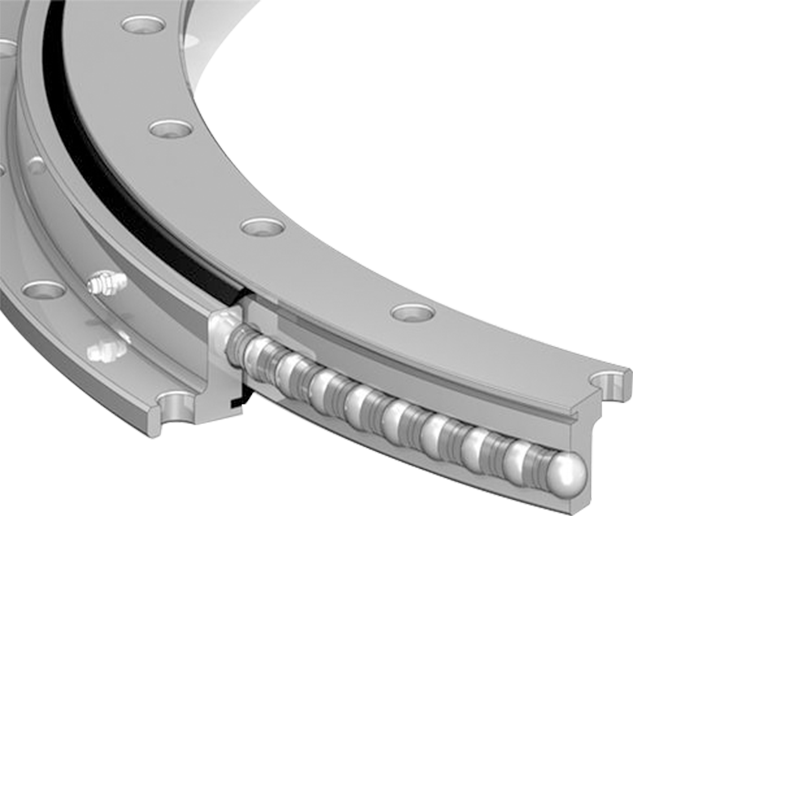How does the design of the L-type slewing bearing enhance its performance in high-load and high-precision applications?
 2024.12.13
2024.12.13
 Industry news
Industry news
Single-Row Ball Design for Balanced Load Distribution
In an L-type single-row ball slewing bearing, the balls are arranged in a single row between the inner and outer rings. This design enables the bearing to support three types of loads simultaneously: axial, radial, and tilting moments. The load distribution is efficient, ensuring that the bearing can handle high loads without compromising on performance. The single-row design provides a simpler, more compact structure, which is ideal for applications where space constraints are a factor.
By efficiently distributing the loads, the L-type bearing can support heavy axial loads (forces parallel to the axis of rotation), radial loads (forces perpendicular to the axis), and moment loads (tilting moments), which makes it particularly useful in heavy-duty equipment like cranes, excavators, and wind turbines.
Optimized Geometry for Load Handling
The L-type design features a relatively large number of balls that have an optimized contact angle with both the inner and outer races. This allows the bearing to handle high axial and radial loads with greater stability and efficiency. The geometry of the ball and raceway contact ensures maximum load capacity while reducing the risk of premature wear, which is critical in high-load applications.
In high-precision environments, such as in construction equipment or robotics, where small deviations can lead to system failures, the precision of the ball’s contact with the raceway ensures minimal backlash or deformation during operation, contributing to smooth, precise motion.
Ball Size and Material Optimization
The size and material of the balls in the L-type bearing are chosen to provide an optimal balance between load capacity and low friction. The balls are typically made from high-strength materials such as chrome steel or ceramic, which provide excellent wear resistance and fatigue strength. This makes them highly effective in applications with continuous or heavy load cycles.
In high-precision systems, the uniform size and shape of the balls help maintain tight tolerances and minimize the risk of vibration or play, which can affect the overall performance and accuracy of the machine.
Compact Design for High Efficiency
The compact design of the L-type slewing bearing allows for a high load capacity in a smaller, more lightweight package. This is particularly important in high-load, high-precision applications where space constraints or weight limitations are important considerations (e.g., in cranes or wind turbines). The compactness of the L-type bearing reduces the overall weight of the rotating mechanism, contributing to better energy efficiency and a more robust system.
Additionally, its compact design allows for easier integration into a wide range of applications without significantly increasing the size of the machine or system, making it a popular choice in industries where space efficiency is critical.

High Precision and Reduced Tolerances
L-type slewing bearings are designed with tight tolerances and are manufactured to high standards of precision. This ensures that the inner and outer races are perfectly aligned, minimizing errors in the rotation and ensuring smooth operation. High precision is essential in applications where even slight misalignments can lead to failures or inefficiencies, such as in robotic arms, turbines, or medical equipment.
The high-precision manufacturing of the bearing components ensures that the system can operate with minimal backlash, which is particularly important in industries where precise movement is necessary, such as in solar tracking systems, aerospace, or medical devices.
Preloaded for Optimal Performance
L-type single-row ball slewing bearings are often preloaded (the internal components are slightly pressed together) to reduce the risk of unwanted movement or play within the bearing. The preload ensures that the bearing operates with optimal stiffness, even under high loads, which is critical in maintaining precision and minimizing wear over time.
In high-load applications, this preload helps the bearing maintain consistent performance over long periods, reducing the need for frequent maintenance and extending the overall lifespan of the equipment.
Resistance to Environmental Factors
Sealed designs in L-type slewing bearings provide protection against dust, dirt, and moisture, which can degrade performance and accuracy in high-load environments. This makes them suitable for applications in harsh environments, such as construction, mining, and offshore drilling, where bearings are exposed to extreme conditions.
Additionally, the design minimizes friction and wear, helping to maintain smooth motion and high precision even in the presence of contaminants or in environments with high levels of vibration.












